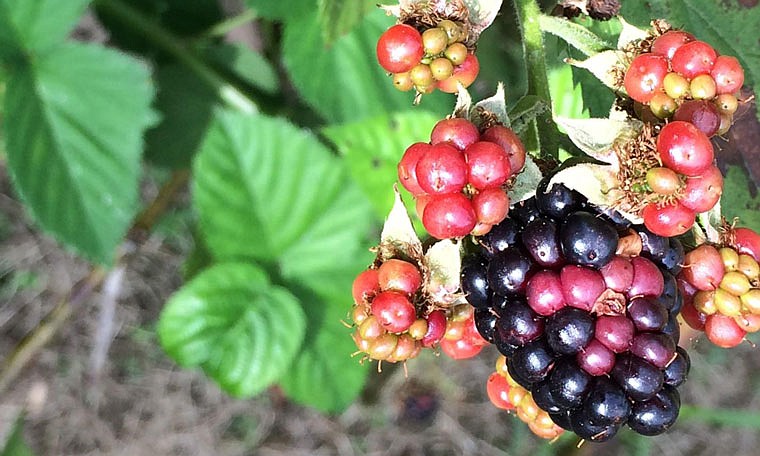Q. Why are my blackberries showing contrasting colors in the same berry? And do they have insect damage?
A. Heat stress is the general cause for poor berry development, which includes uneven coloring as well as small, scrappy berries. It is aggravated by too little moisture. So, given it was quite rainy and then in the last week it has been drying out some and hot, heat is likely the cause. Premium blackberries develop with weather conditions typical of western Oregon - cool and moist. We have plant varieties well adapted to our climate, but fruit quality can suffer in hot summer conditions.
The berry is composed of a bunch of tiny fruits clumped together. Individually these are called drupelets. On the largest berry in the picture, one can see a couple of drupelets that are tan and look like flat balloon. This is the likely result of feeding by a stink bug, which is a common pest of blackberries (as well as many other crops).
Q. What hornet, bee or wasp is this?
A. Well, this is really neat. This is the male of the somewhat well-known velvet ants. There are three main ones in Missouri, with this coloration matching the common eastern velvet ant. Generally, the females get noticed crawling on the ground as large and colorful ants that are fuzzy, too.
The reputation of velvet ants is notorious, first described to me as "cow killers." While that may be an exaggeration, our "Insects in Kansas" reference book says "females sting severely." There is some difference between the species on intensity of stings, with one having given rise to the "cow killer" folklore as "a sting is so painful that it could kill a cow."
Velvet ants are non-aggressive, so just give them space. What they live on is interesting: the female prowls around on the ground to parasitize other wasps and bees with nests in the ground. She lays her eggs in the larvae in those nests. The male is not commonly seen, which is why it is neat you found him.
There is a bit of public curiosity on these remarkable insects, and a safe way to observe them is via YouTube. This two-minute clip shows both males and females: youtube.com/watch?v=d0RK7eKcUM4.
Q. These Japanese beetles are feasting on my elm tree. Do they carry Dutch elm disease?
A. Some good news is Japanese beetles do NOT transmit Dutch elm disease. This devastating elm tree disease is transmitted by elm bark beetles. They burrow below the bark, which moves the fungal spores into the vascular tissue to germinate and infect the tree. The beetles pick up these spores from previously infected trees, as they leave those to search for more habitat.
This disease is particularly devastating to our famed American elm (Ulmus Americana). One tree popularly used as a replacement, and which is resistant, is the Chinese elm. It is not as attractive as the American elm. Good news on this front is two promising American elm cultivars, Valley Forge and New Harmony, are showing good Dutch elm disease resistance.
Yet there is more to this story, for there are other elms species native to Missouri, such as Slippery elm (Ulmus rubra) and rock or cork elm (Ulmus thomasii)t. In addition to these, some elms introduced from other countries have escaped into the environment, such as the winged elm (Ulmus alata). All these other elms are of variable resistance to Dutch elm disease, meaning not all elms growing out in the country are fated to perish of the disease. But many elms that grow naturally in farmsteads and the like do eventually die of the disease. It is possible to identify the species one has; then one can check into the resistance level typical of that species.
The Central Missouri Master Gardeners are a volunteer group of 191 members, 122 of whom are Cole County residents, who maintain 11 beautification sites in Cole County. Master Gardeners must complete a basic training program of at least 30 hours of horticultural training including landscaping, lawns, vegetables, flowers and fruits, as well as 30 hours of volunteer service.
Have a gardening question of your own? The Central Missouri Master Gardeners hotline is staffed from 12:30-4:30 p.m. Tuesdays and Fridays; call 634-2824 then or anytime to leave a message, or email [email protected].

